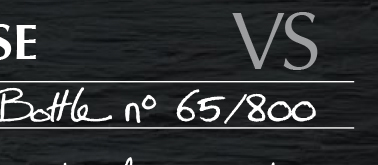The collector Value of a bottle of cognac is multi-dimensional:
[Age of bottle] X [Quality of cognac] X [Brand Luxury] X [Terroir] X [Rarety of the model] X [condition of the bottle] X [number available].
1. Age of Bottle:
Cognac was bottled in the seventies has less value than something produced in 1920s.
Cognac was bottled in the seventies has less value than something produced in 1920s.
In the case of a Vintage cognac, extra value is added as there is a clear year associated with the cognac, plus it might have been re-bottled at a later stage and that dates also has a value.
2. Quality of Cognac
Most cognac is stated with these English terms as you all know cognac is mostly a spirit exported out and consumed outside of France, hence the use of English terms when qualifying cognac. Age and quality depends on the time the cognac has spent in oak casks - not the age of the bottle.
Most cognac is stated with these English terms as you all know cognac is mostly a spirit exported out and consumed outside of France, hence the use of English terms when qualifying cognac. Age and quality depends on the time the cognac has spent in oak casks - not the age of the bottle.
* VS= Very Special = 2 years old and more spent in oak cask. In French = Vieille Fine.

- Comandon Partial Back Label VSOP
* VSOP = Very Superior Old Pale = 4 years old and more spent in oak cask. In French = Tres Vieille Fine.
* XO = Extra Old = 6 years old and more spent in oak cask. In French = Hors d'Age.
* Extra = 6 years old and more spent in oak cask, but it is supposedly older. No French translation, just another Hors d'Age.
* Extra = 6 years old and more spent in oak cask, but it is supposedly older. No French translation, just another Hors d'Age.
3. Brand Luxury
Different brands have different appeal, status, prestige and notoriety.
Different brands have different appeal, status, prestige and notoriety.
Some are popular, other are more obscure but more famous amongst connoisseurs, etc.
4. Terroirs:
There are 7 different areas in Cognac which produces specific cognacs associated with the area.
There are 7 different areas in Cognac which produces specific cognacs associated with the area.
These 7 areas have an 'unofficial picking order' which is unfortunate but a reality imposed by 100 years of political and economical reasoning. The following order is the most recognized order in terms of 'prestige of the terroirs' NOT MY OPINION.
1st Grande Champagne
2nd Petite Champagne
3rd Fine Champagne
4th Borderies
5th Fins Bois
6th Bons Bois
7th Bois Ordinaires
2nd Petite Champagne
3rd Fine Champagne
4th Borderies
5th Fins Bois
6th Bons Bois
7th Bois Ordinaires

- Petite Champagne Cognac, Partial Label
5. Condition of the Bottle:
Most important is the amount of liquid left in the bottle, the quality of closure and its condition, the condition of the labels, and the packaging. Also to consider is the design and intrinsic packaging designs. For instance, decanters are more valuable than standard bottles, as well as wood boxes are worth more than cardboard packagings.
Most important is the amount of liquid left in the bottle, the quality of closure and its condition, the condition of the labels, and the packaging. Also to consider is the design and intrinsic packaging designs. For instance, decanters are more valuable than standard bottles, as well as wood boxes are worth more than cardboard packagings.
6. Number Available:
Limited editions are more valuable in the long run than standard productions. In addition, the 'known' number of bottles still available make an impact in the overall 'exclusivity' value of the bottle.
Limited editions are more valuable in the long run than standard productions. In addition, the 'known' number of bottles still available make an impact in the overall 'exclusivity' value of the bottle.

- Comandon VS Partial Label
No comments:
Post a Comment